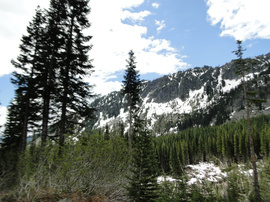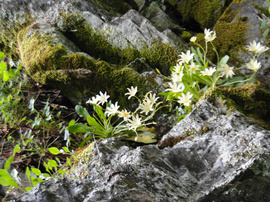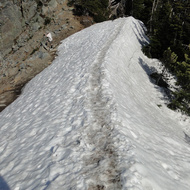Scary crossing Chatter Creek with huge Spring runoff.
During our quadruple-year drought, hiking Chatter Creek was easier, albeit extremely steep. Multiple creek crossings were low or completely dry.
After heavy winter snow, Spring runoff was huge. In late May I hiked Chatter Creek trail with Karen and Gro. Later I took Rich on that hike. He called it "climbing Mt. Everest."
Creek crossings got harder as we gained elevation. When we got to the biggest creek crossing, I froze. Chatter Creek was huge, fast and crashing over waterfalls, wet, slippery boulders, logs and sharp rocks. To cross, I needed to climb a giant flat-faced boulder, negotiate slippery rocks and logs, and walk across a sharply tilted, nearly vertical tree trunk that fell across the creek, jammed against the boulder.
“No way,” I thought and dropped downhill, scouting for an easier crossing. I managed to cross a waterfall to a island in the creek, but there was no way to get to the other side.
Discouraged, I returned to the original crossing. Karen and Gro were magically on the far side of Chatter Creek. Karen nimbly scrambled back, asking, “Are you afraid?” Terrified.
“Hand me your pack and hiking pole,” Karen said. I collapsed the pole, strapping it to my pack. Karen scrambled halfway across, tossing my day pack to Gro. “Wow, your pack is heavy!” Gro exclaimed, staggering after catching it. “What's in there, the kitchen sink?”
“Kathleen, we are going to use rock climbing skills,” Karen explained. “Always keep limbs anchored; move a single hand or foot at a time. I will go slowly. Follow me and put your hands and feet exactly where I put mine.”
“Put your left foot here. Now boost yourself and grab this edge with your right hand. Brace yourself with your left foot and right hand.” Together we scrambled the boulder wall like spiders. Negotiated slippery rocks and logs. Next was the sharply tilted log. Walking the log was impossible.
“Now straddle the log like riding a horse, letting your legs dangle down the side,” Karen said. “Use your hands to scoot yourself forward.” We edged around protruding branches. At the end of the log, I was high above the ground. Tricky getting down.
During the descent, that scary creek crossing was much easier. I had mentally rehearsed and knew I could do it. As a small woman, it is often easier to sit down and slide off boulders, landing downhill on my feet. On the far side, Karen reached out and helped Gro and me jump across the water to the slippery, steep bank.
Descending, Karen and I both fell in the same extremely steep spot. Suddenly my front foot shot out from under me and I did the splits. Sliding downhill, my left shin and knee dragged painfully across sharp rocks and dirt.
“Are you all right?” Karen asked. “It’s just a scratch,” I replied merrily, my pat answer to minor hiking injuries.
A fortnight later, those deep bruises and bloody scrapes were still healing. But I felt triumphant. Hiking builds self-confidence when we face challenges and surmount them.
Photos:
An easier creek crossing. Mountains around us. Craggy cliffs in the high meadow.
Tweedy's Lewisia grows just in North Central Washington at specific elevations and exposures. My favorite wildflower.



Enjoy being online again!
Welcome to the community of good people who base their values on evidence and appreciate civil discourse - the social network you will enjoy.Create your free account
6 comments
Feel free to reply to any comment by clicking the "Reply" button.Sounds risky to the point where you may wish to reconsider?
It's a judgment call. I rarely turn back because I don't want to spoil the hike for others. Usually I steel myself and make myself keep going. Sometimes I crawl across a log- suspended over rushing rapids- like a baby bear. In extremely steep areas, I descend on the seat of my pants.
Two situations are a flat no:
-
Avalanche danger in early Spring warmth.
-
Extremely dangerous knife-edge trails. I hate that. Huge drop-offs on both sides of a narrow trail. Of course the trail is never flat.
If the log in the picture is the one you got across the creek on, you are nuts. I would never do that as I would end up in the water, hurting and perhaps broken. That hurts. I am glad you made the trip and the pictures are great as always.
That was an easier crossing. The huge tilted log was nearly vertical.
Enjoy being online again!
Welcome to the community of good people who base their values on evidence and appreciate civil discourse - the social network you will enjoy.Create your free account
Share this post
Categories
Agnostic does not evaluate or guarantee the accuracy of any content. Read full disclaimer.












